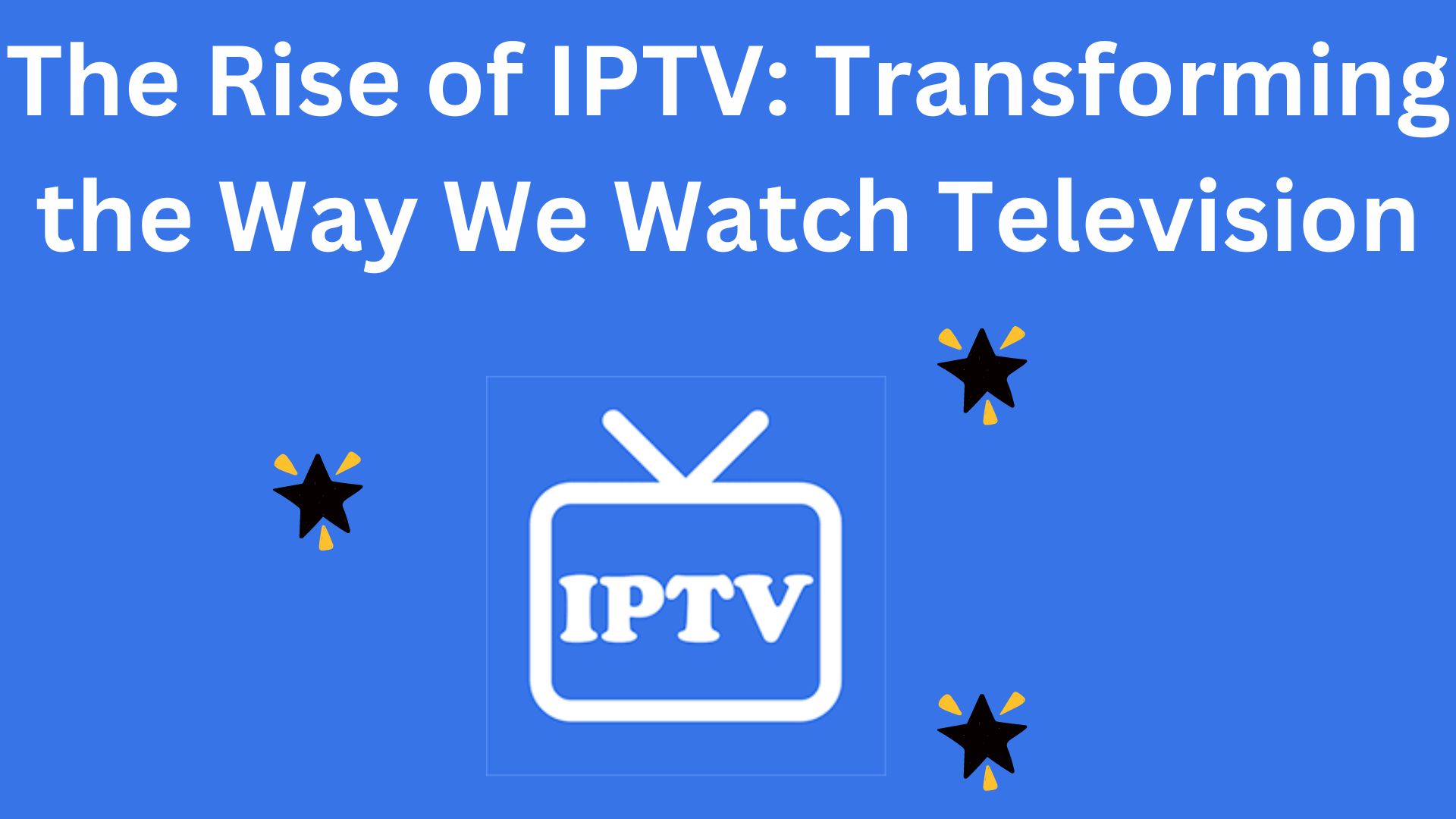
The Rise of IPTV: Transforming the Way We Watch Television the ever-evolving landscape of television and media consumption, a paradigm shift is taking place with the

emergence of Internet Protocol Television (IPTV). This innovative technology is revolutionizing the traditional television viewing experience, offering consumers unparalleled choice, flexibility, and customization. With IPTV, viewers are no longer confined to the constraints of linear broadcasting, but instead, embark on a journey of on-demand, interactive, and personalized entertainment.
This article delves into the world of IPTV, exploring its definition, history, technology, benefits, and potential challenges. By examining the current state and future prospects of IPTV, we aim to provide a comprehensive understanding of this transformative technology and its impact on the television industry.
What is IPTV?
IPTV is a technology that delivers television content and services over the Internet or private IP networks. It utilizes Internet protocols to transmit and receive digital television signals, enabling users to access live TV, video-on-demand (VOD), time-shifted media, and other interactive services.
At its core, IPTV differs from traditional broadcast or cable television in its delivery mechanism. Instead of receiving television signals through antennas, satellite dishes, or coaxial cables, IPTV relies on a stable internet connection to stream content directly to users’ devices. This convergence of television and internet technologies offers a host of advantages and opens up new avenues for content delivery and consumption.
A Brief History of IPTV
The concept of IPTV is not entirely new, but its commercialization and widespread adoption have gained momentum in recent years. The roots of IPTV can be traced back to the late 1990s when pioneering companies began experimenting with streaming media over IP networks.
One of the earliest examples of IPTV was demonstrated by BT (British Telecommunications) in 1995. They showcased a system called “Video-on-Demand over IP” which allowed users to select and watch video content on their computers via a broadband connection. This early experiment laid the groundwork for the development of IPTV as a viable technology.
In the early 2000s, several telecom and media companies began investing in IPTV, recognizing its potential to disrupt the traditional television market. Telecom giants such as AT&T, Verizon, and Orange started offering IPTV services, leveraging their existing broadband infrastructure.
However, the turning point for IPTV came with the widespread availability of high-speed internet and the proliferation of streaming services. The increasing bandwidth capacities and improving compression technologies enabled the delivery of high-quality video content over the internet, making IPTV a feasible and attractive option for consumers.
IPTV Technology and Architecture
Understanding the underlying technology and architecture of IPTV is crucial to grasp its unique capabilities and advantages. Here’s a simplified breakdown of the key components:
-
Content Source: IPTV content can originate from various sources, including live television broadcasts, video-on-demand servers, or even user-generated content. The content is typically encoded and compressed using formats such as MPEG-4 or H.264 to reduce bandwidth requirements.
-
IPTV Service Provider: The service provider plays a central role in the IPTV ecosystem. They are responsible for acquiring content from various sources, packaging it into channels or VOD offerings, and delivering it to subscribers via the internet. IPTV service providers also manage user authentication, billing, and other value-added services.
-
Network Infrastructure: IPTV relies on a robust and reliable network infrastructure to deliver content seamlessly. This includes high-speed internet connections, such as fiber optic cables, DSL, or broadband, to ensure sufficient bandwidth and low latency for streaming video content.
-
Set-Top Box or IPTV Device: To receive IPTV services, users typically require a set-top box (STB) or an IPTV-enabled device. These devices decode the incoming IP packets and convert them into audio-visual signals that can be displayed on a television or other display device. Some modern smart TVs come with built-in IPTV functionality, eliminating the need for a separate set-top box.
-
Video Streaming Protocols: IPTV utilizes specific streaming protocols, such as RTSP (Real Time Streaming Protocol), HLS (HTTP Live Streaming), or MPEG-DASH, to deliver content in real-time or on-demand. These protocols ensure smooth playback, adaptive bitrate streaming, and efficient content delivery.
-
User Interface and Interactive Features: IPTV service providers often offer a customized user interface, providing a personalized and intuitive viewing experience. This includes electronic program guides (EPGs), search functions, recommendations, and interactive features such as pause, rewind, and catch-up TV.
Benefits of IPTV

IPTV offers a plethora of benefits to both consumers and the television industry. Here are some key advantages:
-
On-Demand Content: One of the biggest advantages of IPTV is the availability of on-demand content. Viewers can choose from a vast library of movies, TV shows, documentaries, and more, and watch them whenever they want. No more waiting for specific broadcast schedules or relying on recordings.
-
Personalization and Customization: IPTV allows users to customize their viewing experience. They can create personalized profiles, set preferences, receive tailored recommendations, and even customize their channel lineups. This level of customization enhances user engagement and satisfaction.
-
Interactive Features: IPTV goes beyond passive viewing by offering interactive features. Users can pause, rewind, and fast-forward live TV, catch up on missed programs, and even interact with the content through quizzes, polls, or social media integration.
-
Multiscreen Experience: With IPTV, viewers are no longer tied to a single device or location. They can seamlessly switch between different screens, such as televisions, computers, smartphones, or tablets, and continue watching from where they left off. This multiscreen experience provides unprecedented flexibility and convenience.
-
Cost-Effectiveness: IPTV can offer significant cost savings compared to traditional pay-TV services. With IPTV, users have the option to subscribe to specific channels or bundles that align with their interests, avoiding the need to pay for unwanted channels.
-
Enhanced Picture and Sound Quality: IPTV delivers content in high-definition or even 4K resolution, providing viewers with a superior picture quality experience. Additionally, IPTV supports advanced audio formats, such as Dolby Digital or DTS, delivering immersive sound to complement the visuals.
-
Targeted Advertising: IPTV enables more precise audience targeting for advertisers. By leveraging user data and viewing habits, IPTV service providers can deliver personalized and relevant ads, increasing engagement and effectiveness.
Challenges and Considerations
While IPTV offers numerous benefits, there are also some challenges and considerations to keep in mind:
-
Internet Speed and Bandwidth: One of the primary requirements for a seamless IPTV experience is a stable and high-speed internet connection. Insufficient bandwidth or inconsistent speeds can lead to buffering, pixelation, or other quality issues. This is particularly important for households with multiple devices streaming simultaneously.
-
Content Piracy and Security: IPTV faces challenges related to content piracy and unauthorized access. Illegitimate IPTV services that offer pirated content have become a growing concern for the industry. Ensuring content security, protecting intellectual property rights, and combating piracy are crucial for the sustainable growth of the IPTV market.
-
Regulatory and Legal Issues: The distribution of television content over the internet introduces complex regulatory and legal issues. IPTV service providers must navigate licensing agreements, geographical restrictions, and compliance with broadcasting regulations, which can vary across regions.
-
Interoperability and Standards: The IPTV ecosystem comprises various hardware and software components from different vendors. Ensuring interoperability between these components and adhering to industry standards are essential to provide a consistent and reliable user experience.
-
Customer Support and Education: As IPTV involves a more complex setup and technology compared to traditional television, customer support and education become critical. Service providers need to invest in robust customer support systems and educate users about the features and benefits of IPTV to ensure a positive experience.
The Future of IPTV

Looking ahead, the future of IPTV holds immense potential and exciting possibilities. Here are some key trends and developments that are shaping the future of IPTV:
-
5G and Mobile IPTV: The rollout of 5G networks is expected to revolutionize the IPTV landscape. With ultra-high speeds, low latency, and increased bandwidth, 5G technology will enable seamless streaming of high-quality video content on mobile devices, opening up new opportunities for mobile IPTV services.
-
Integration with IoT and Smart Home: IPTV is poised to become an integral part of the Internet of Things (IoT) and smart home ecosystems. Integration with smart devices, voice assistants, and home automation systems will allow users to control and interact with their IPTV services through voice commands, gesture controls, or automated routines.
-
Enhanced Interactive Features: IPTV providers are continuously innovating to enhance the interactive capabilities of their platforms. This includes the integration of social media, gaming, and interactive advertising, as well as the development of second-screen experiences that provide complementary content or interactive features on mobile devices.
-
Personalized Advertising and Recommendations: With advancements in data analytics and machine learning, IPTV service providers will be able to offer highly personalized advertising and content recommendations. By analyzing viewer behavior, preferences, and demographics, they can deliver targeted ads and tailored content suggestions, enhancing user engagement and monetization opportunities.
-
360-Degree and Virtual Reality (VR) Content: IPTV is also exploring immersive viewing experiences through 360-degree and virtual reality content. By delivering spherical or stereoscopic video streams, IPTV platforms can offer viewers a fully immersive and interactive experience, transforming the way they engage with entertainment, sports, or educational content.
Conclusion
IPTV is reshaping the television industry, empowering viewers with unprecedented control, flexibility, and choice. The convergence of television and internet technologies has unlocked a world of on-demand content, interactive features, and personalized experiences. While challenges and regulatory considerations exist, the benefits and potential of IPTV are undeniable.
As we move forward, the future of IPTV promises exciting innovations with the advent of 5G, IoT integration, and immersive content. The lines between traditional television and online streaming will continue to blur, giving rise to a dynamic and transformative entertainment landscape. For consumers, this means a richer, more engaging, and highly customized viewing experience.
The evolution of IPTV underscores the relentless march of technology, forever changing the way we watch and interact with television.
References
-
“History of IPTV.” IPTV Magazine,
-
“What is IPTV? Internet Protocol Television Explained.” BroadbandNow,
-
“IPTV Technology, Architecture, and Ecosystem.” Cisco,
-
“Benefits of IPTV.” Teleste,
-
“Challenges and Future Trends of IPTV.” Medium,
-
“5G and the Future of IPTV.” Telecoms.com,
-
“Immersive Media and the Future of IPTV.” Medium,